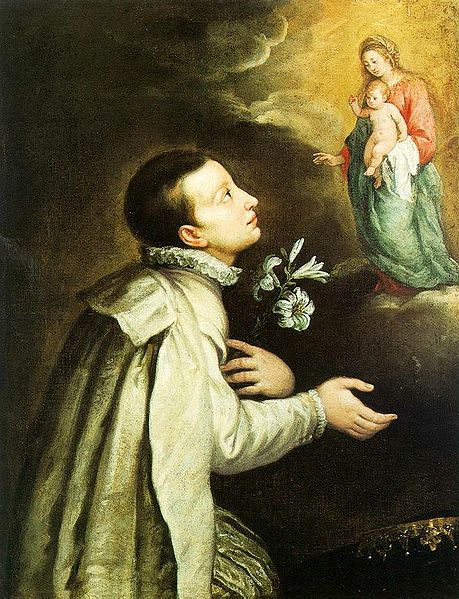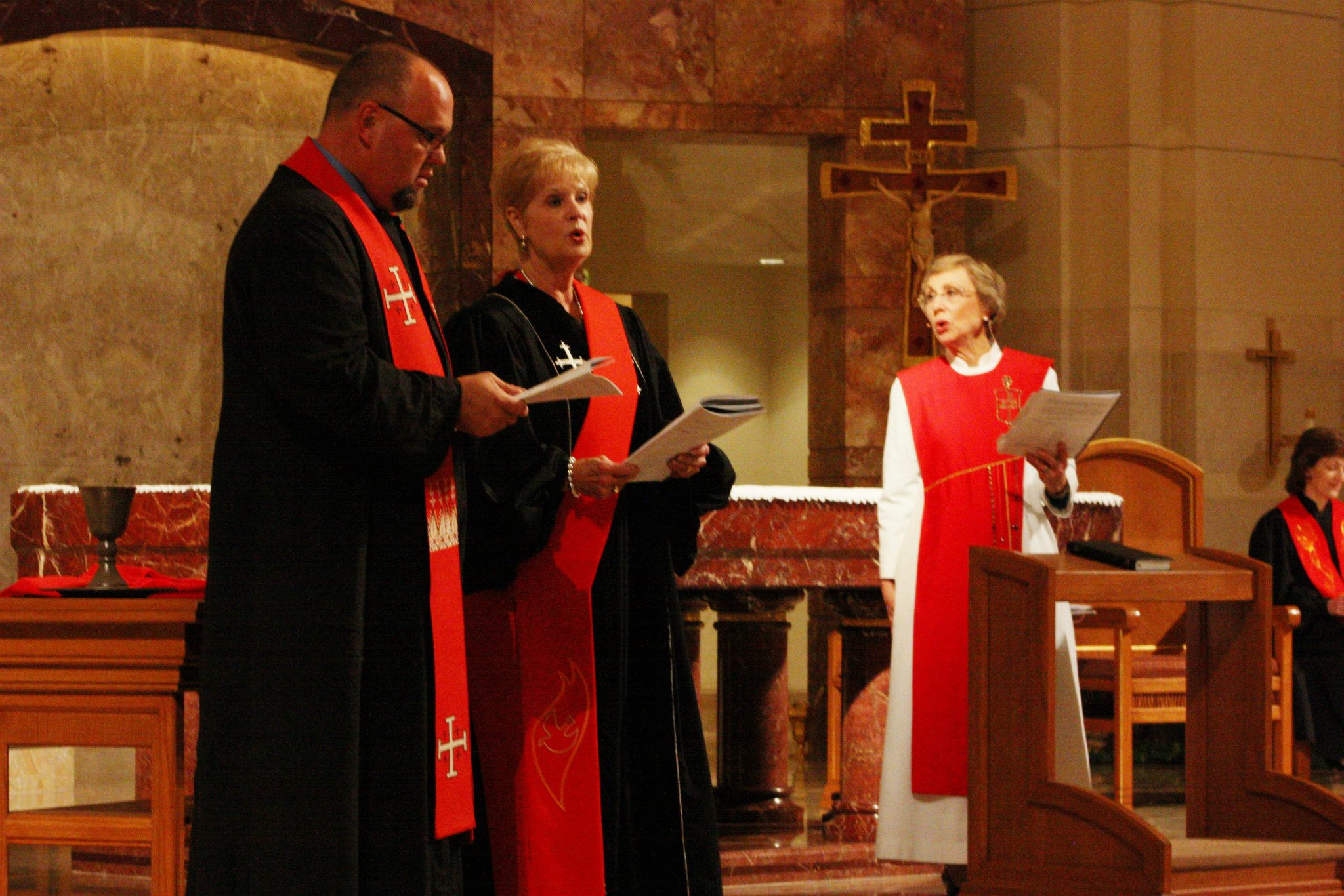Sacred Heart-St. Louis
in Gervais, Oregon
June 23rd, 2013
Dominica XII Per Annum,
Anno C.
“If anyone wishes to come
after me,
he must deny himself
and take up his cross daily
and follow me.”
Friday was the feast day of
St. Aloysius Gonzaga. This young saint died at the age of 23. His confessor,
St. Robert Bellarmine, testified that young Aloysius had never mortally
offended God. At lunchtime on Friday, I was eating lunch with another priest
and two young men who are discerning their possible vocations to the
priesthood. We got in a conversation about St. Aloysius. The mere mention of
this young saint’s name called to mind the beauty of his pure soul. St.
Aloysius is the patron saint of youth, which applies to teenagers and also to
young adults who are single. He is especially appointed to these because of his
purity.
Can you imagine what it
would be like to glimpse the soul of a saint? What would his soul look like? I
would dare to say that if God allowed us to see the beauty of St. Aloysius’
pure soul, we would weep.
Why do I say that? Because
true beauty wounds us. The beauty of which I speak is what we call the
transcendental beauty of God. In other words, the beauty of God transcends all
earthly beauty. Beauty is one of the transcendental qualities of God. For
instance, we say that God is the fullness of Truth, Goodness, and Beauty. These
are called the transcendental qualities of God because they transcend earthly
truth, earthly goodness, and earthly beauty. All created things that are
beautiful pale in comparison with the fullness of beauty which we find in God.
We call these created things beautiful by analogy only. Nothing can be truly
beautiful that is not God Himself. But we see glimpses of God’s beauty in
created reality…and the nearer things are to God, the more beautiful they are.
So when we consider the beauty of a pure soul; the soul of a saint like that of
St. Aloysius sanctified in heaven; of course his soul would pale in comparison
with the beauty of God, but it would still be so beautiful by analogy that we
would weep at the mere sight of it.
Perhaps that is one aspect
of the Cross about which our Blessed Lord speaks in the Gospel. He says “If
anyone wishes to come after me, he must deny himself and take up his cross
daily and follow me.” Can we say then that beauty is a cross, or even a burden?
I propose that we can. To discover beauty brings with it an obligation to guard
and protect that beauty because it is precious. Truth, goodness, and beauty all
necessitate that we guard and protect them because they are precious. This is a
cross.
It is a cross because once
one discovers truth, then one feels the burden of spreading that truth. But it
is not a burden to speak truth and defend it. It is an absolute joy to know
truth, to speak truth, and to defend truth. The burden, or cross, of Truth is
the grief that one experiences when others reject Truth. One grieves for the
souls of those who reject truth. Those souls will never know true joy because
they are deprived of that which causes true joy. That which causes true joy is Truth
Himself, who is God. Jesus Christ declares this. He says “I AM the Truth.” To
embrace the absolute Truth incarnate, Jesus Christ, is a cross. But it is a
necessary cross that we must pick up daily and carry.
Goodness too is a cross for
the same reason. There will be those who reject goodness. And there are those
who reject beauty. And so beauty too is a burden, a cross. Beauty is a cross in
a different way. Let me clarify that when I refer to beauty, I am not referring
to that which is pretty or attractive. Beauty is much greater than that because
it is a reflection of God.
When one experiences true beauty, then that person’s
life changes. That person must carry the cross of grief knowing that others
chase after created things which are not beautiful…nor true…nor good.
And yet the Truth,
Goodness, and Beauty of God would surely change the lives of all men if only
they could come to discover these and embrace them. St. Peter was given the
truth of who Jesus is: the Christ, the Son of God. Flesh and blood did not
reveal this to him, but our Heavenly Father revealed it by means of the Holy
Spirit of Truth. It brought St. Peter great joy throughout his life when hearts
were converted to Jesus Christ, who IS Truth incarnate. But it surely brought
him great sorrow when people he spoke to, preached to, and cared about rejected
Jesus Christ and the Gospel.
In our day and age, there
is a rejection of truth, goodness and beauty. People are willing and even
wanting to settle for less. It is as though they are repelled by beauty and
therefore by goodness and truth.
Beauty is looked upon with
distrust and even disdain by many in the artistic community, as though “beauty
is a bad thing” (Wolfe). In a (lecture given at the CL School of Community in
Portland a few years ago), (Professor) Gregory Wolfe asked: “What is the
impetus for the in-your-face ugliness of modern art?” He answered this
rhetorical question by citing Plato’s Republic. According to Plato, poets were
dangerous because they employed beauty in order to seduce. Wolfe continued:
“Pleasure scares us because it is powerful.” Puritans and Marxists judged
beauty to be dangerous to justice and truth in the order of society. The result
of this attitude has been the separation of beauty from art. Art has become subjective,
while beauty has been tamed “by making it pretty” (Wolfe). (Andersen. Hymnody
in the Roman Breviary. p. 44).
Can we see the same thing
happening with marriage? Ever since society accepted the separation of
procreation from marriage, the institution of marriage has become subjective.
But marriage is not subjective. It has nothing to do with whether one thinks
one is married. It is an objective, binding, and legal fact. One is either
married–objectively and legally–or not.
Marriage is a reflection of
the love of God. St. Paul calls the love of Christ for His Church a spousal
love which is reflected in the love of a man for a woman in marriage. He calls
marriage a great sacrament that applies to Christ and His Church. Marriage
therefore participates in the True, Good and Beautiful because it is a
reflection of God. Marriage transcends the earthly relationship because it
participates in a heavenly reality. When one fully realizes the Truth,
Goodness, and Beauty of marriage, then one is obliged to defend and guard it.
Therein lies the Cross, especially today when marriage is under attack. We hear
again the words of the Lord: “If anyone wishes to come after me, he must deny
himself and take up his cross daily and follow me.”
We as Catholics are in a
position to defend many things which are true, good, and beautiful. Marriage
seems to be at the forefront today. The current political situation calls for
the Church to stand up and vigorously defend marriage. Not only must we defend
marriage, but we must defend our freedom to defend marriage. This Fortnight for
Freedom which the Church has proclaimed in our great country, seeks to make you
the Catholic faithful aware that our religious freedom is threatened. Truth is
being obscured. Goodness is being mocked. Beauty is being degraded.
We are made for beauty, for
goodness, and for truth. We are made in the image and likeness of God, and
since God is the fullness of Truth, Goodness, and Beauty, we participate in
these qualities and are to imitate Him and reflect Him in these qualities. In
this is the cross of Christ that we are to carry. We have been given so much.
We cannot keep it to ourselves. We must guard and protect all that is truly
good, truly beautiful. We must guard and protect the institution of marriage.
That will be our cross. It is a joyful Cross, a light burden, a sweet yoke.
Like the pure soul of a
saint like St. Aloysius, if we were to see the beauty of holy matrimony as God
sees it, it would make us weep. It would wound us in such a holy way that our
lives would be changed. We would take up that cross and proclaim it to the
world. We must live, however, by faith and not by sight. Perhaps we have not
been given the gift to see that transcendent beauty. But many of us have wept
at the sight of something holy and beautiful. That is a gift from God and a
cross that we must embrace. We are given this beautiful cross to carry: to
guard and defend the truth, goodness, and beauty of holy matrimony between one
man and one woman, as a lifelong union for the procreation and raising of
children and the good of the spouses. What a beautiful cross. Let us carry this
cross daily and follow Jesus wherever He leads us.









